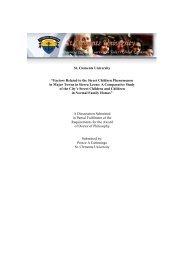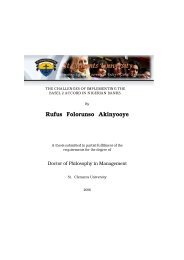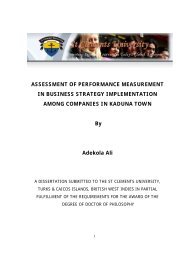The role of informal microfinance institutions in saving
The role of informal microfinance institutions in saving
The role of informal microfinance institutions in saving
You also want an ePaper? Increase the reach of your titles
YUMPU automatically turns print PDFs into web optimized ePapers that Google loves.
It further def<strong>in</strong>es sav<strong>in</strong>gs and credit cooperation societies (SACCOs) <strong>in</strong> the follow<strong>in</strong>g manner:-<br />
� A f<strong>in</strong>ancial enterprise Controlled by an association <strong>of</strong> persons.<br />
� An association composed <strong>of</strong> sav<strong>in</strong>gs and borrow<strong>in</strong>g co-owners.<br />
� A f<strong>in</strong>ancial enterprise with objectives different from those <strong>of</strong> a bank that seeks to<br />
maximize the cooperative advantages <strong>of</strong> its members through sav<strong>in</strong>g/ borrow<strong>in</strong>g<br />
schemes.<br />
� An enterprise operated through special laid down rules.<br />
Development International Desjard<strong>in</strong>s (2005) further dist<strong>in</strong>guish two types <strong>of</strong> SACCOs<br />
accord<strong>in</strong>g to their membership status. <strong>The</strong>se are SACCOs with a homogeneous membership i.e.<br />
Members belonged to the same social category and SACCOs with a heterogeneous<br />
membership i.e. members not belonged to the same social category.<br />
2.1.2 <strong>The</strong> concept <strong>of</strong> portfolio <strong>in</strong>vestment.<br />
Investors, whether firms or <strong>in</strong>dividual <strong>in</strong>vest their funds/money or resources on the<br />
expectation that <strong>in</strong> future, they are go<strong>in</strong>g to receive back their money (on the sell<strong>in</strong>g the<br />
<strong>in</strong>vestment) plus additional amount known as a return at a certa<strong>in</strong> time or <strong>in</strong>tervals <strong>of</strong> time<br />
and less risk. A return is <strong>in</strong>come and a change <strong>in</strong> market price <strong>of</strong> the <strong>in</strong>vestment that an<br />
<strong>in</strong>vestor receives from <strong>in</strong>vest<strong>in</strong>g his funds <strong>in</strong>to different types <strong>of</strong> <strong>in</strong>vestment. A return may be<br />
dividends, <strong>in</strong>terest or pr<strong>of</strong>it, or else depend<strong>in</strong>g on the nature <strong>of</strong> the project where the fund is<br />
<strong>in</strong>vested. Other factors affect<strong>in</strong>g decisions <strong>of</strong> <strong>in</strong>vestors <strong>in</strong> relations as to where to <strong>in</strong>vest his<br />
funds are: - liquidity, marketability, time value <strong>of</strong> money, pr<strong>of</strong>itability and risk <strong>of</strong> the<br />
respective projects where the fund will be <strong>in</strong>vested.<br />
A return may be measured either as under a condition <strong>of</strong> certa<strong>in</strong>ty or under a condition <strong>of</strong><br />
uncerta<strong>in</strong>ty. When the condition is deemed as uncerta<strong>in</strong>ty, a return is measured as the average<br />
return obta<strong>in</strong>ed by summ<strong>in</strong>g the outcomes <strong>of</strong> returns which are then multiplied by their<br />
respective probability <strong>of</strong> occurrence. On the other hand, the rate <strong>of</strong> return refers to the return<br />
97
















